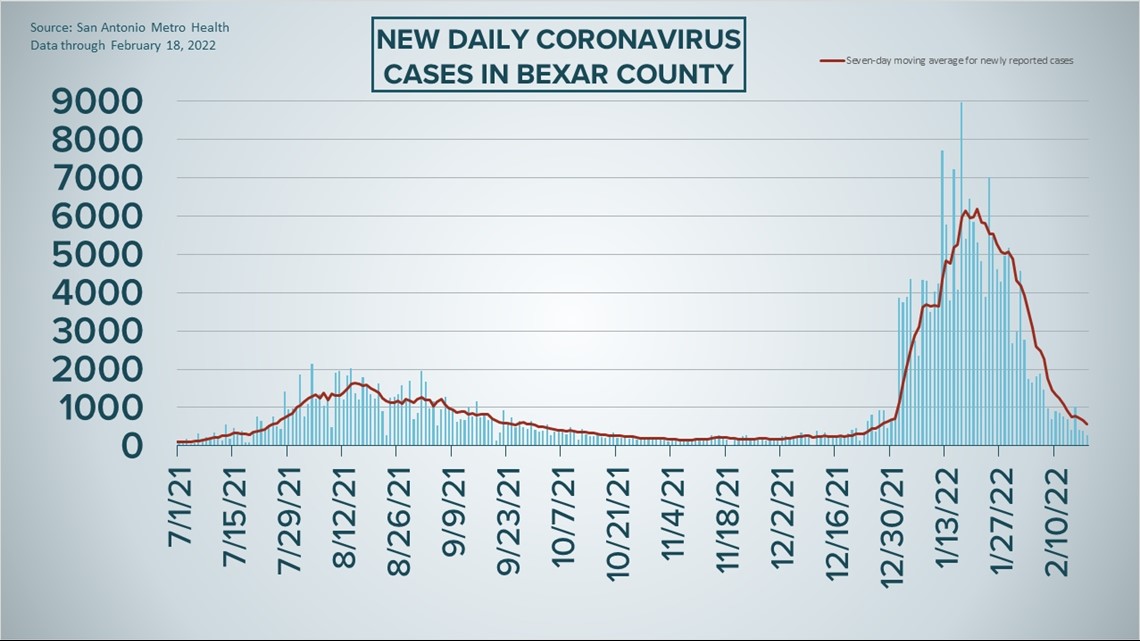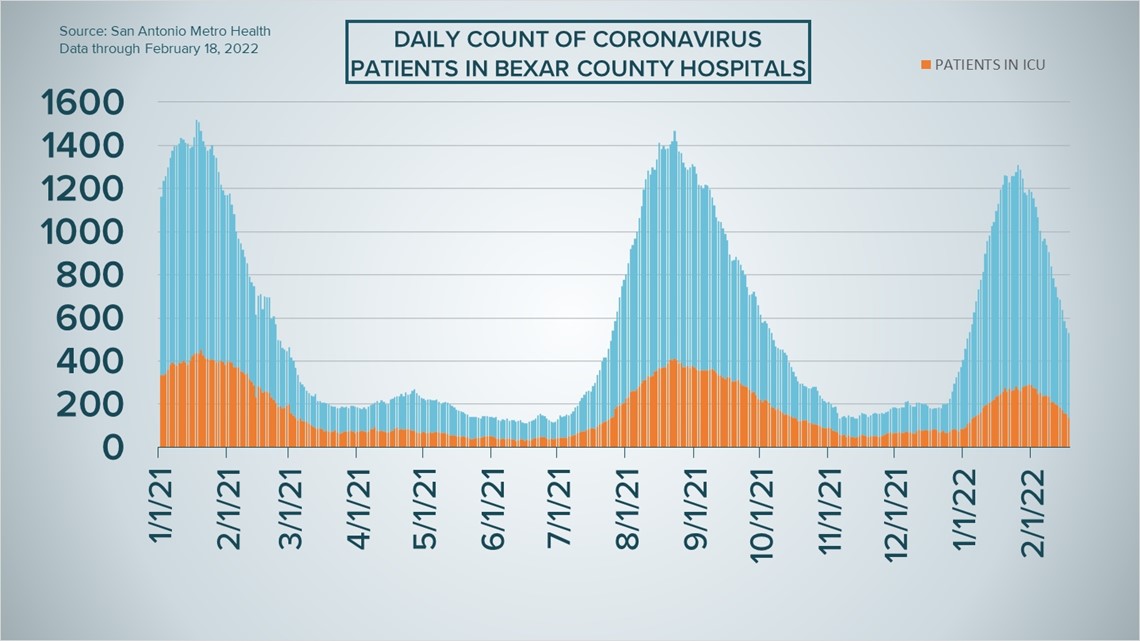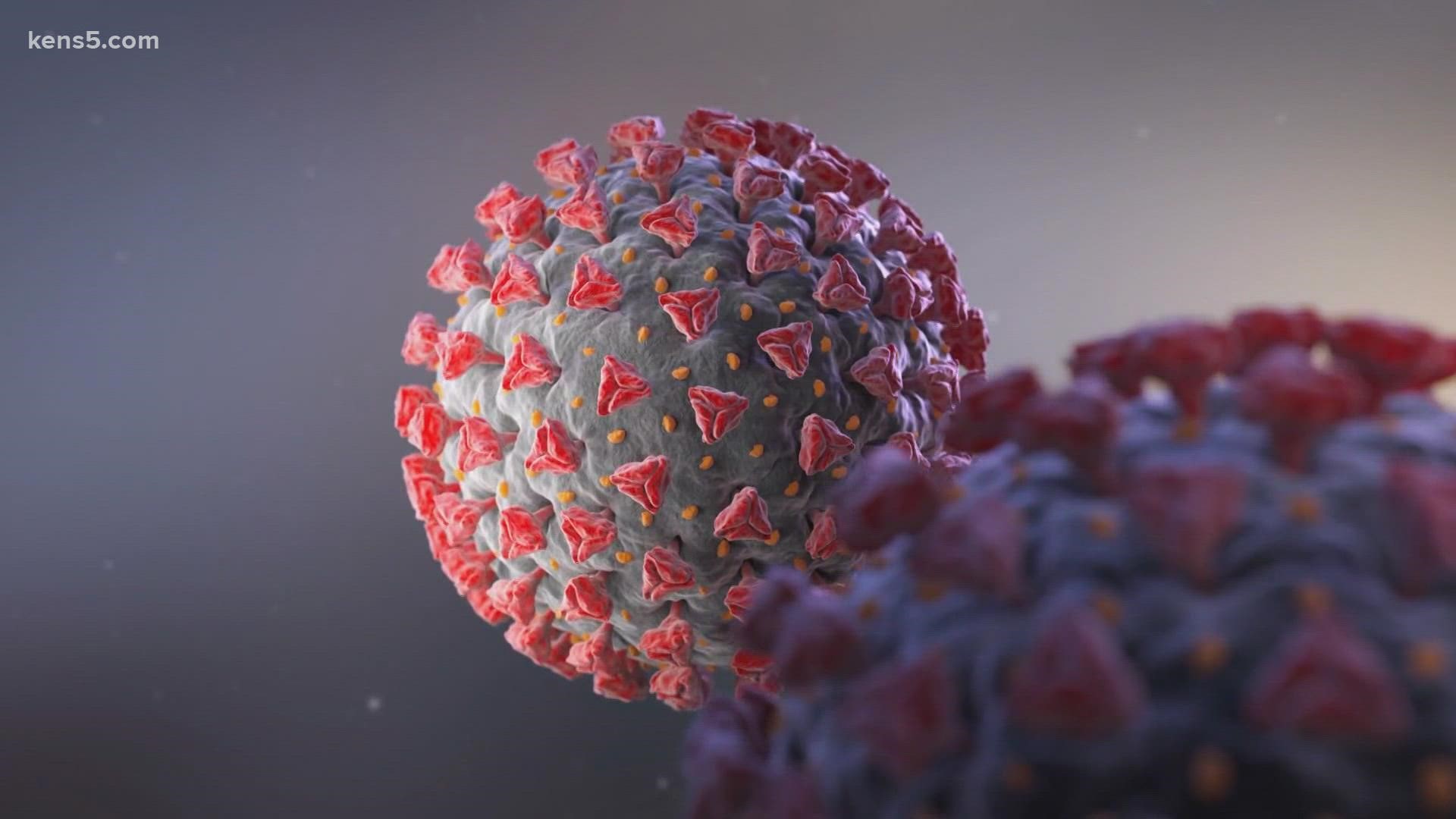SAN ANTONIO — For the fourth time this week, Bexar County health authorities tallied a new 2022 low for daily COVID-19 infections, with 280 additional ones reported Friday. The seven-day case average decreased once more as a result to 572, the lowest since Dec. 27.
But while February has brought drastically lower case counts – an average of 1,298 new diagnoses a day, compared to nearly 4,200 in January – local virus-related deaths are trending upward. Eleven more fatalities were reported by Metro Health Friday, bringing this month's total to 131; that's already more than the community saw in all of January.
A total of 5,227 county residents have died from COVID-19 complications, while more than 518,000 have been diagnosed.
Meanwhile, local hospitalizations fell for an 11th straight day, this time to 532. January 3 was the last time there were that few Bexar County patients receiving treatment for their symptoms, and hospitalizations have gone down by 32% over the last week alone.
Of those 532 patients, 137 are in intensive care and 77 are on ventilators; both are also decreases from Thursday.
How Bexar County is trending




Vaccine Progress in Bexar County
The following numbers are provided by San Antonio Metro Health. A full breakdown can be found here.
- 1.743 million eligible Bexar County residents have received at least one dose of the coronavirus vaccine as of Thursday, Feb. 17.
- 1.42 million eligible Bexar County residents are fully vaccinated as of Thursday, Feb. 17.
The CDC states that "when a high percentage of the community is immune to a disease (through vaccination and/or prior illness)," that community will have reached herd immunity, "making the spread of this disease from person to person unlikely."
The City of San Antonio breaks down the vaccination rates by zip code on Metro Health's Vaccination Statistics page.
Coronavirus in Texas
The total number of coronavirus cases in the state since the pandemic began grew by 10,475 on Friday, according to the Texas Department of State Health Services. That total includes 8,367 new confirmed cases and 2,108 new probable cases. More details can be found on this page.
Friday's figures bring the total number of Texans diagnosed with COVID-19 to more than 6.5 million.
An additional 240 Texans have died from virus complications, meanwhile, raising the statewide death toll to 82,084.
Coronavirus symptoms
The symptoms of coronavirus can be similar to the flu or a bad cold. Symptoms include fever or chills, cough, shortness of breath or difficulty breathing, fatigue, muscle or body aches, headache, new loss of taste or smell sore throat, congestion or runny nose, nausea or vomiting, and diarrhea, according to the Centers for Disease Control.
Most healthy people will have mild symptoms. A study of more than 72,000 patients by the Centers for Disease Control in China showed 80 percent of the cases there were mild.
But infections can cause pneumonia, severe acute respiratory syndrome, kidney failure, and even death, according to the World Health Organization. Older people with underlying health conditions are most at risk.
Experts determined there was consistent evidence these conditions increase a person's risk, regardless of age:
- Chronic kidney disease
- COPD (chronic obstructive pulmonary disease)
- Obesity (BMI of 30 or higher)
- Immunocompromised state (weakened immune system) from solid organ transplant
- Serious heart conditions, such as heart failure, coronary artery disease, or cardiomyopathies
- Sickle cell disease
- Type 2 diabetes
- The CDC believes symptoms may appear anywhere from two to 14 days after being exposed.
Human coronaviruses are usually spread...
- Between people who are in close contact with one another (within about 6 feet).
- Through respiratory droplets produced when an infected person coughs, sneezes or talks. These droplets can land in the mouths or noses of people who are nearby or possibly be inhaled into the lungs.
- Some recent studies have suggested that COVID-19 may be spread by people who are not showing symptoms.
Help stop the spread of coronavirus
- Stay home when you are sick.
- Eat and sleep separately from your family members
- Use different utensils and dishes
- Cover your cough or sneeze with your arm, not your hand.
- If you use a tissue, throw it in the trash.
Find a Testing Location
City officials recommend getting a COVID-19 test if you experience fever or chills, cough, shortness of breath or difficulty breathing, fatigue, muscle or body aches, headache, new loss of taste or smell, sore throat, congestion or runny nose, nausea or vomiting, or diarrhea.
Here's a Testing Sites Locator to help you find the testing location closest to you in San Antonio.
Latest Coronavirus Headlines
- Texas sues CDC to stop mask mandates on planes
- South Korea to give out rapid tests as omicron shatters record
- Verify: Yes, the coronavirus pandemic will eventually become an endemic
- US Surgeon General Vivek Murthy tests positive for COVID-19
- Estimated 73% of US now immune to omicron: Is that enough?
- 'Most sincere condolences' | SAFD engineer passes away after battling COVID-19 complications

